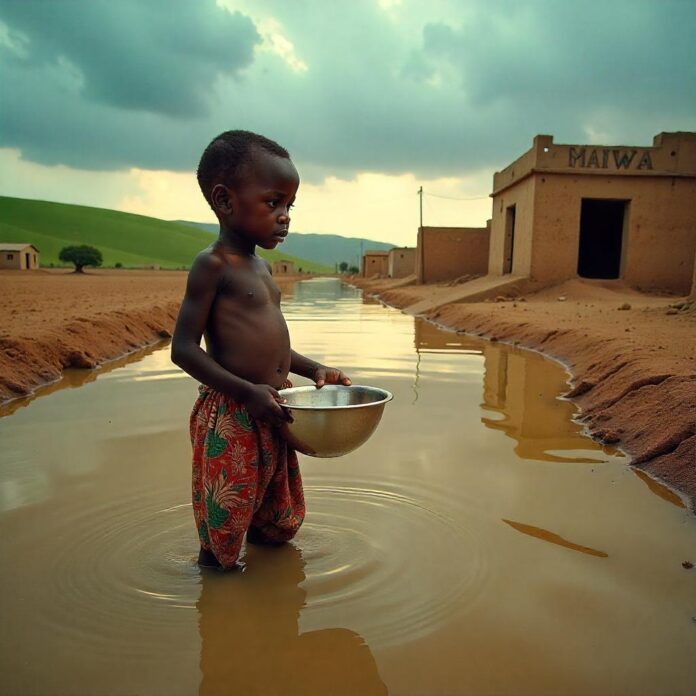Nigeria—Africa’s most populous nation and once a regional breadbasket—now grapples with a harrowing food insecurity crisis that threatens to unravel decades of development. As of July 2025, a staggering 30.6 million Nigerians are projected to face acute hunger during the June-August lean season, with hotspots in the northwest and northeast nearing catastrophic levels. The northern regions, destabilized by conflict and climate disasters, epitomize the emergency: Zamfara, Sokoto, and Katsina report 713,000 people in Emergency conditions, while Borno and Yobe hover on famine’s edge. This crisis transcends temporary hardship; it signifies a systemic collapse demanding global attention.
The Anatomy of a Crisis
The Human Toll
Children in Peril: 17 million Nigerian children suffer malnutrition—the highest number in Africa and second globally after India. In the northeast alone, 1.8 million children battle severe acute malnutrition, a condition causing irreversible cognitive damage and heightened mortality. Displacement and Desperation: Over 10 million West Africans are displaced by violence and climate shocks. Nigerian IDPs in camps like Borno’s Monguno subsist on one meal daily, with many resorting to scavenging wild leaves or begging.
Geographic Hotspots
North East: Boko Haram splinter factions blockade farmlands in Borno, Adamawa, and Yobe. Traders risk death on roads peppered with insurgent checkpoints; markets lie in ashes. North West: Bandit “taxes” on farmers in Sokoto and Katsina have slashed sorghum yields by 50%. Meanwhile, 2024 floods drowned 1.6 million hectares of farmland—a $1 billion loss equivalent to a year’s food for 13 million people.
Drivers of Despair
Conflict: The Primary Catalyst
Armed groups weaponize food systems. In Zamfara, bandits seize harvests at gunpoint, while in the Middle Belt, herder-farmer clashes erupt over dwindling resources. Result: 30-50% post-harvest losses for staples like millet, and 4.2 million farmers displaced from their fields.
Climate Chaos
Floods and Droughts: The 2024 deluge affected 9.2 million Nigerians, obliterating bridges and silos critical for north-south food transport. Concurrently, 2025’s erratic rainfall slashed wheat output by 40% in Jigawa and Kano. Temperature Extremes: Sahelian temperatures rising 1.5× faster than global averages have sterilized 35% of traditional grazing lands, triggering mass livestock deaths.
Economic Meltdown
Hyperinflation: Staple prices have rocketed—beans by 282%, rice by 153%—since the 2023 fuel subsidy removal. The naira’s 70% devaluation against the USD means even middle-class families now skip meals. Policy Gaps: National food security strategies remain underfunded and fragmented, with state-level responses uneven at best. Rural communities receive less than 10% of federal agricultural subsidies.
Humanitarian Response Under Siege
Funding Shortfalls
The World Food Programme faces a $710 million deficit for West Africa. Without immediate cash injections, 5 million Nigerians will lose food assistance by August 2025. Rations for remaining recipients have already been halved.
Access Barriers
Physical Blockades: In Borno, militants loot 40% of aid convoys. The UN Humanitarian Air Service—a lifeline for remote areas—may halt Mali/Nigeria flights next month due to funding gaps. Bureaucratic Hurdles: Customs delays at Lagos ports stall grain shipments for weeks, while aid worker visa bottlenecks paralyze field operations.
The Lean Season Crisis
From June-August 2025, 52.7 million West Africans will confront emergency hunger. Nigeria’s northwest faces Emergency conditions, with 1.2 million people one step from famine.
Pathways to Resilience
Localizing Aid
Cash-Based Interventions: WFP now channels $200 million/year into Nigeria’s economy via local food purchases and e-vouchers. In Plateau State, women’s cooperatives supply nutrient-rich crops to WFP, creating self-sustaining income loops. Farm-to-Fork Networks: Linking IDP camps with nearby farms in “conflict-cooled” zones has cut food transport costs by 25% while boosting smallholder incomes.
Climate-Smart Innovations
Loss Reduction: Solar-powered dryers and hermetic storage bags slash post-harvest losses by 70%. The AfDB’s 1 million-hectare climate-resilient wheat project in Jigawa demonstrates scalable yields. Flood Adaptation: FAO promotes amphibious rice varieties in Rivers State, while watershed management in Taraba has reclaimed 50,000 flood-ravaged hectares.
Policy Overhauls
Trade Reforms: The 2024 UN Pact for the Future advocates transparent regional trade corridors to bypass bandit-infested routes. Cross-border agreements with Niger and Cameroon could cut maize prices by 30%. Inclusive Investment: Nigeria must develop bankable portfolios blending grants, concessional loans, and private capital. Bundling road repairs with solar cold storage in Katsina could reduce spoilage by 40%.
A Call for Global Solidarity
The Cost of Inaction: Famine in Sudan—confirmed in 2024 after a four-year hiatus—proves starvation is a political choice. For Nigeria, UN Secretary-General António Guterres warns: “Hunger in the 21st century is indefensible. We cannot respond to empty stomachs with empty hands”. What You Can Do: Advocate: Demand G7 nations honor $620 million in pending Sahel aid pledges. Support: $0.50/day funds a child’s nutrient-rich meal via WFP’s school feeding program. Amplify: Share stories like Fatima’s—a Borno mother who revived her millet farm using flood-tolerant seeds—to combat crisis fatigue.
Beyond Emergency to Endurance
Nigeria’s extreme hunger crisis is neither natural nor inevitable. It is the outcome of intersecting failures—in security, economics, and climate policy. Yet within northern Nigeria’s “pockets of resilience,” women’s cooperatives, youth-led logistics startups, and returning farmers prove recovery is possible. Investing in these frontline innovators, while deploying aid as an economic catalyst, can transform desperation into durable food sovereignty. The question, as WFP’s David Stevenson frames it, is no longer “Can we afford to help?” but “Can we afford not to?”
Nigeria’s Food Crisis: Key Statistics
| Indicator | 2024 | 2025 Projection |
|---|---|---|
| Food Insecure Population | 26.1 million | 33.1 million |
| Children Acutely Malnourished | 4.3 million | 5.4 million |
| Flood-Affected Farmland | 1.6 million ha | n/a |
| WFP Funding Gap | $620 million | $710 million |
Timeline: Nigeria’s Descent into Hunger Crisis
- 2020: 4 million in lean-season hunger
- 2023: Fuel subsidy removal → inflation surge
- 2024: Historic floods → $1B crop loss
- 2025: 33.1 million face starvation


